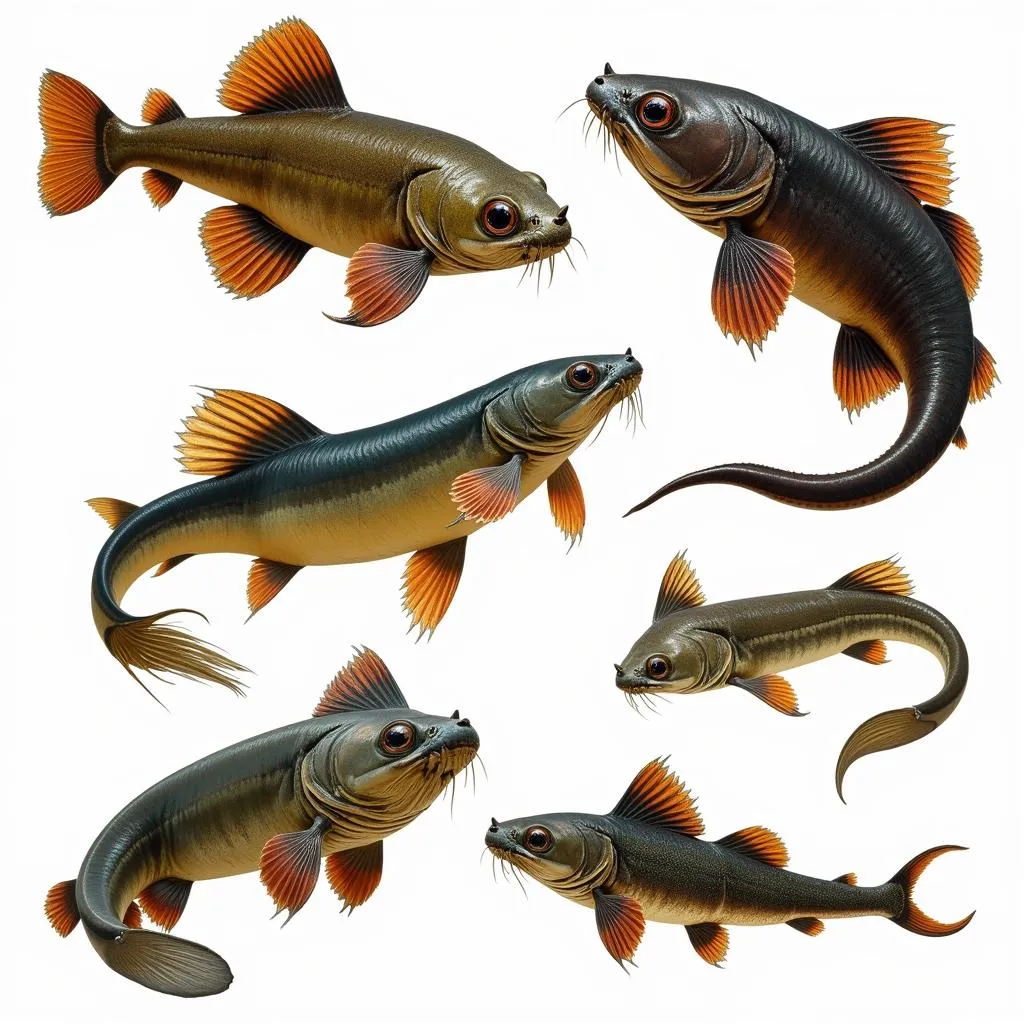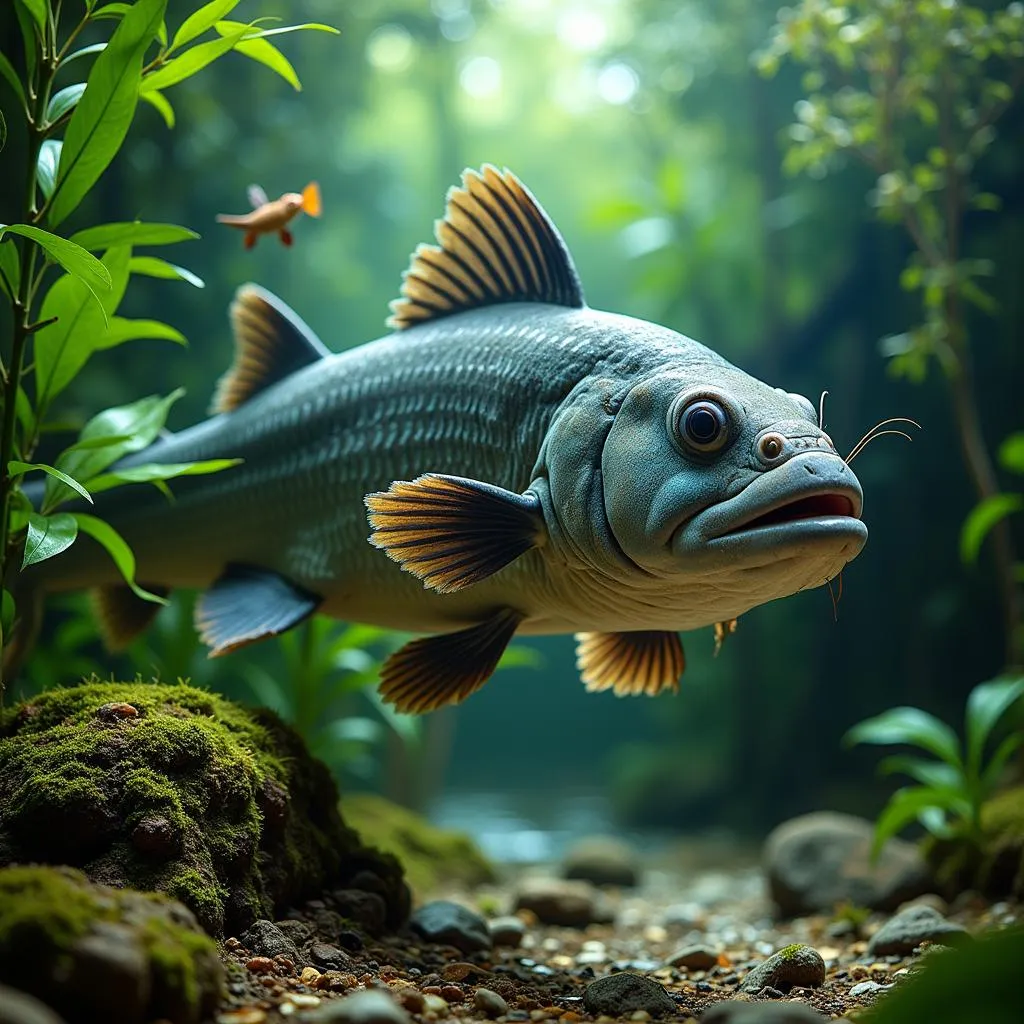Exploring the Diverse World of African Catfish Species
The African continent is home to a remarkable diversity of freshwater fish, with catfish (Siluriformes) holding a prominent position. African Catfish Species, renowned for their hardiness and adaptability, inhabit a range of aquatic ecosystems, from vast lakes and mighty rivers to seasonal streams and floodplains. These whiskered wonders have captivated the attention of aquarists, anglers, and biologists alike, each drawn to their unique characteristics and ecological importance.
A Myriad of Shapes and Sizes: Delving into African Catfish Diversity
African catfish species exhibit an astonishing array of shapes, sizes, and adaptations. From the diminutive upside-down catfish (Synodontis nigriventris) known for its peculiar swimming habit, to the formidable goliath catfish (Arius gigas) reaching lengths of over six feet, the diversity within this group is astounding. Some species, like the electric catfish (Malapterurus electricus), possess the remarkable ability to generate electric shocks for defense and hunting, while others, like the squeaker catfish (Synodontis eupterus), produce audible sounds through their pectoral spines.
 African Catfish Species Diversity
African Catfish Species Diversity
Habitats and Adaptations: African Catfish in Their Element
African catfish species have evolved to thrive in a wide range of aquatic habitats, each with its own set of challenges and opportunities. The Nile catfish (Synodontis batensoda), for example, has adapted to the murky waters of the Nile River, relying on its sensitive barbels to detect prey in low-visibility conditions. In contrast, the butterfly catfish (Schilbe mystus), found in shallow, fast-flowing streams, possesses a streamlined body and powerful fins, enabling it to navigate turbulent currents with ease.
Ecological Role: African Catfish as Keystone Species
Beyond their fascinating adaptations, African catfish species play crucial roles in maintaining the ecological balance of their respective habitats. As omnivores, they contribute to nutrient cycling by consuming decaying organic matter, algae, and invertebrates. Their presence also helps to regulate prey populations, ensuring the overall health of the ecosystem.
 African Catfish in Their Natural Habitat
African Catfish in Their Natural Habitat
Conservation Concerns: Protecting African Catfish Species
Unfortunately, many African catfish species face growing threats from human activities. Overfishing, habitat destruction, pollution, and the introduction of invasive species have all taken a toll on catfish populations. The construction of dams, for instance, can disrupt migratory patterns and alter natural flow regimes, impacting breeding cycles and food availability.
Sustainable Management: Ensuring the Future of African Catfish
Protecting African catfish species and their habitats requires a multifaceted approach that emphasizes sustainable fishing practices, habitat conservation, and pollution control. Implementing fishing quotas, establishing protected areas, and promoting responsible aquaculture are essential steps towards ensuring the long-term survival of these remarkable fish.
African Catfish in Culture and Cuisine
African catfish species hold cultural and culinary significance in many parts of the continent. They feature prominently in local folklore, traditional ceremonies, and are considered a dietary staple in numerous communities. Their firm flesh and mild flavor make them a versatile ingredient, enjoyed grilled, fried, smoked, or stewed in flavorful sauces.
 African Catfish in Traditional Cuisine
African Catfish in Traditional Cuisine
Conclusion: Appreciating the Rich Tapestry of African Catfish
From their diverse adaptations to their ecological and cultural significance, African catfish species offer a captivating glimpse into the continent’s aquatic biodiversity. By understanding the challenges they face and supporting conservation efforts, we can help safeguard these fascinating fish for generations to come.
FAQs
What is the largest African catfish species?
The goliath catfish (Arius gigas) is the largest African catfish species, reaching lengths of over six feet and weighing up to 200 pounds.
Are all African catfish species edible?
Yes, most African catfish species are edible and considered a valuable food source in many regions.
What are some threats to African catfish populations?
Overfishing, habitat destruction, pollution, and the introduction of invasive species are major threats to African catfish populations.
How can I contribute to African catfish conservation?
You can support sustainable fishing practices, reduce your environmental footprint, and spread awareness about the importance of protecting these fascinating fish.
Where can I learn more about specific African catfish species?
Reputable online resources, scientific journals, and books on African freshwater fish can provide detailed information about different catfish species.
Can African catfish be kept in aquariums?
Yes, some African catfish species are popular in the aquarium trade. However, it’s crucial to choose species that are suitable for your tank size and provide them with appropriate care.
What is the ecological importance of African catfish?
African catfish contribute to nutrient cycling, regulate prey populations, and play a vital role in maintaining the health of their ecosystems.
For further assistance regarding African catfish species or related inquiries, please reach out to us at +255768904061 or kaka.mag@gmail.com. You can also visit us at Mbarali DC Mawindi, Kangaga, Tanzania. Our dedicated customer support team is available 24/7 to address your needs.
